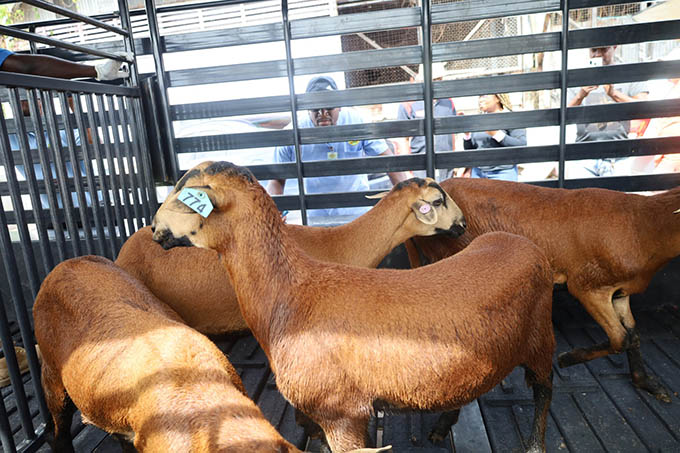Months after the launch of a major Black Belly Sheep Project in West Coast Berbice by President Irfaan Ali, the first batch of the ruminants arrived in Guyana yesterday from Barbados.
A total of 112 ewes and 20 rams were among the first of 1,000 sheep slated to arrive here under the initiative between the two governments, which aims at reducing the region’s mutton import bill.
The remainder of the sheep will be transported to Guyana within the coming months.

Before being handed over to the farmers, the Guyana Livestock and Development Authority (GLDA) will spearhead a weaning exercise to introduce them into Guyana’s climate and their new diet.
Agriculture Minister Zulfikar Mustapha who was present at the arrival, said this represents the kind of results they are looking for from bilateral relations. He noted that once the project is on stream, the region will benefit significantly from a reduced importation bill.
“This here will be a very important project for Guyana and the Caribbean, this here is where we are working to reduce the food import bill. When you look at the importation of meat and meat products in the Caribbean it amounts to a large percentage of foreign revenue and we are looking to move away from that.”
Of the 1,000 sheep expected to arrive here, 30 per cent will be given to women, 20 per cent to youths, and the remainder will be divided among farmers and persons living with a disability.
Mustapha stated that they are working to ensure the pens are ready for when the remainder of the sheep arrive here so they can be properly housed. The pens are being constructed in Region Five.
He explained that some 1,400 acres of land has also been made available for the rearing of the sheep.
“When we make commitments we take it seriously and this is the kind of results we are looking at…” he declared.
The Agriculture Minister also disclosed that efforts will be made to create a Caribbean brand of black belly sheep.
“The president has announced that this is an important programme where we want to create a Caribbean brand of black belly here… Prime Minister Mia Mottley, when she was in Guyana said she wants us to also breed a new breed of sheep, a mixed breed, between the Guyana local sheep. So we are looking to work in those two directions.”
The Barbados Prime Minister’s Envoy to Guyana, Alphea Wiggins, who was also present, added that the arrival of the sheep here signals the commitment by the two countries to fighting challenges in food security.
According to Wiggins “This is the ongoing collaboration and as you know (at) Agro-Fest, we had 150 Guyanese there and the relationship between Barbados and Guyana will continue to develop and it will be the envy, not only of Caricom, but the rest of the world.”
She stated that when the agreements are concluded, Guyanese and Barbadian citizens will be able to benefit from tremendous opportunities.
“This is a momentous occasion between Guyana and Barbados where we have seen the St Barnabas Accord in full action.”
It was noted that some 100 farmers have already signed up to be a part of the project.
When President Ali launched the programme back in March, it was disclosed that the project will attract an initial investment of US$3 million. At the time he said the project will make Region Five the livestock capital of the country.
According to the President, the vision for the project is first to be “self-sufficient” – supply locally – then move on to supplying regionally, and then the international market.
Ali had explained that the project will need an overall investment of US$175 million from the government, farmers, and international players. In his over 60-minute presentation, he pointed out that the target is to increase local production above 7,000 tons by the end of year five, as according to him this is a realistic target given the investment. He also detailed projected production to years 10 – 20 and financial projections with the creation of 4500 jobs, directly and indirectly.
Further, some 78 farmers who have land have already signed up to be part of the project. The president has encouraged others to come on board explaining that after Region Five is examined the other communities will be built to target the gap.
Farmers in the project are expected to develop the pastures with grass and legumes, while the GLDA will provide technical and veterinary services.
However, Ali stressed that the sheep farmers and GLDA will have to collaborate to ensure that accurate data is provided and proper monitoring of animal performance is done.
Touching on the opportunities which will come with the industry, he noted that the world import value for mutton products is US$8 billion which is 1.2 billion metric tons “and it is a growing market.”
Caricom, Ali had informed, imports 7,900 tons to the tune of US$48 million and is being supplied by Australia and New Zealand. He noted that the four major markets for small ruminants in Caricom are The Bahamas, Jamaica, Trinidad and Tobago and Barbados.
The President had also mentioned the plan to invest in training programmes and bring technology to the farmers and that a “dedicated team” including a vet will be hired to work with the farmers in support of the sector.





